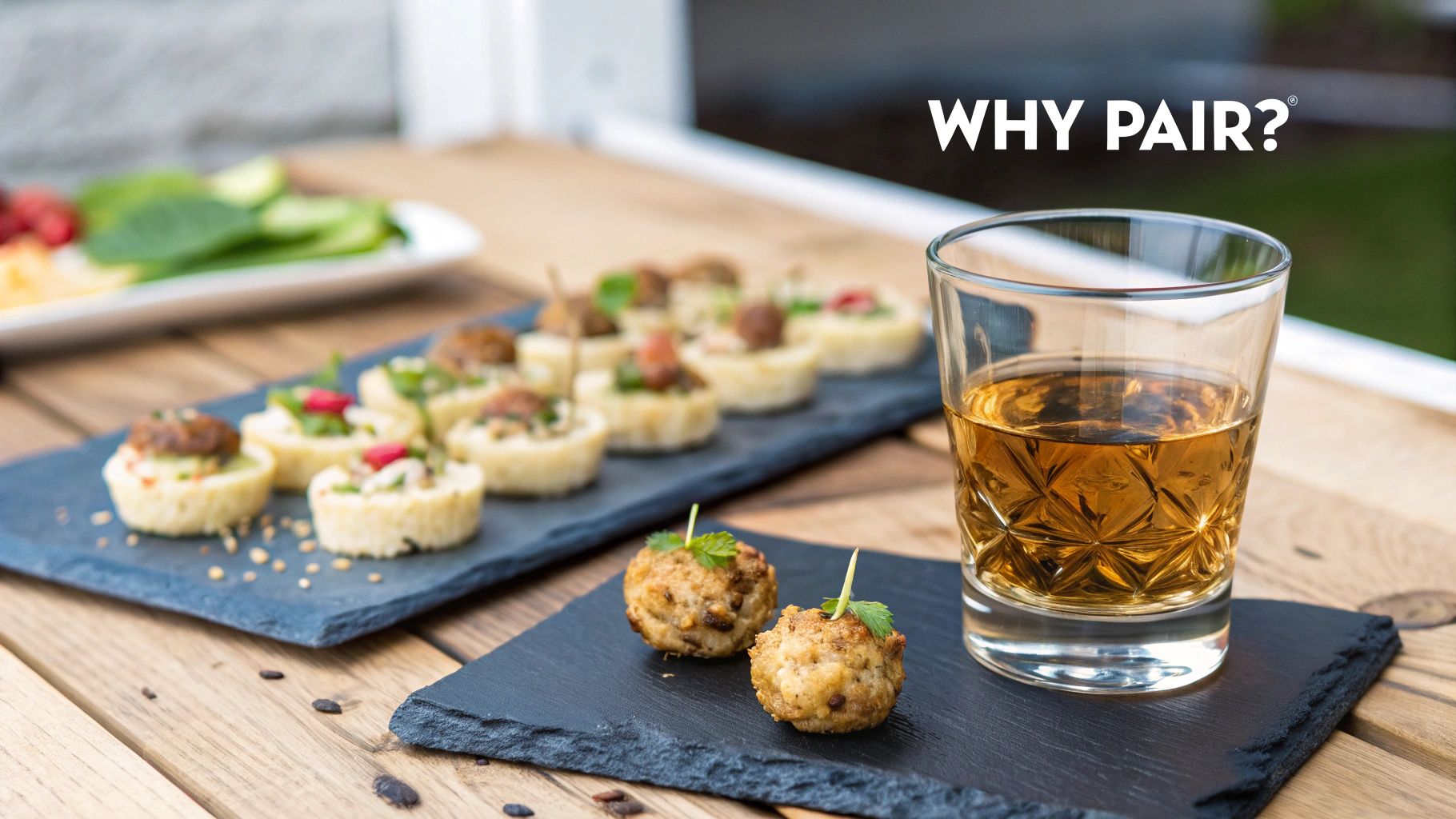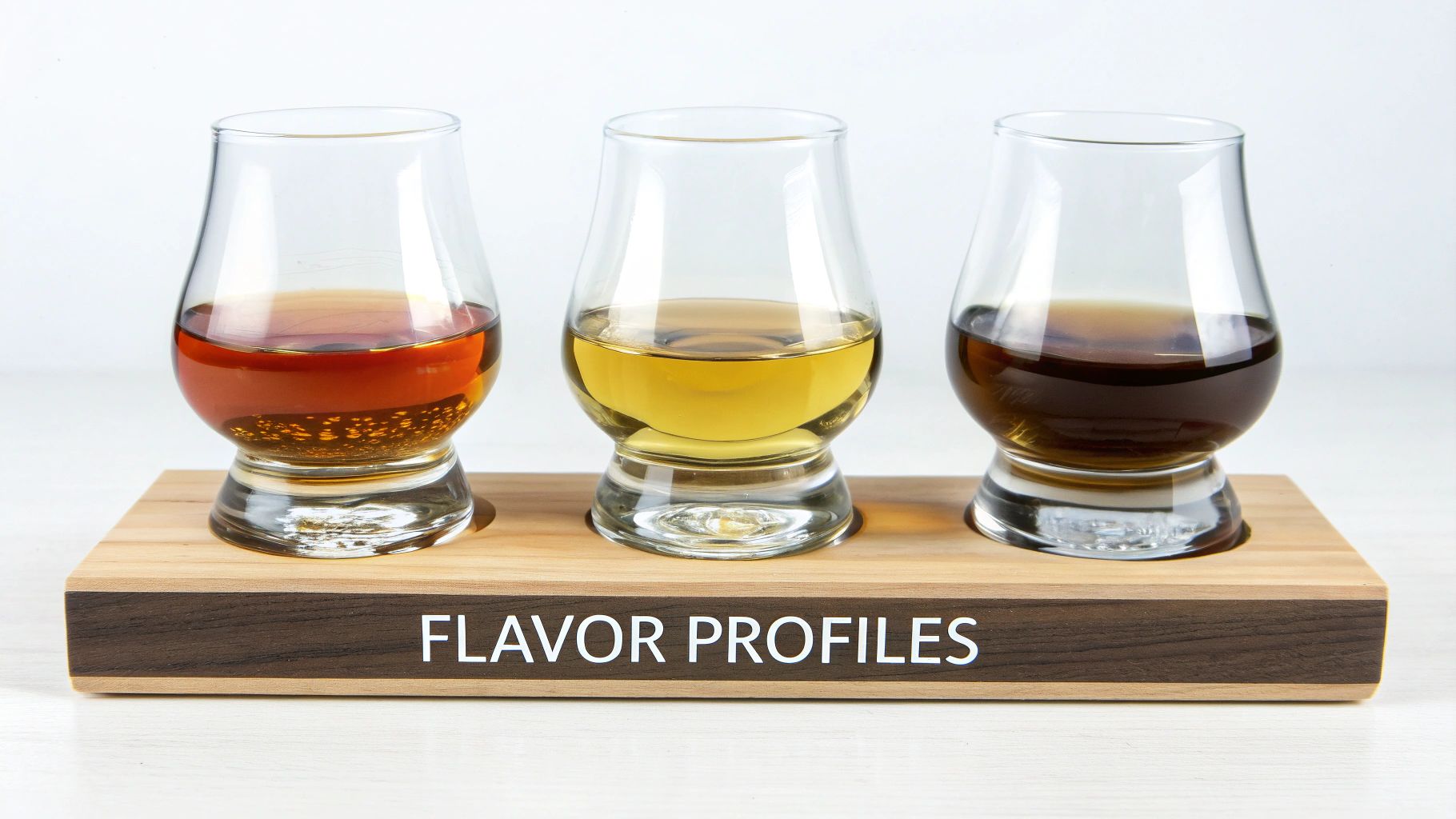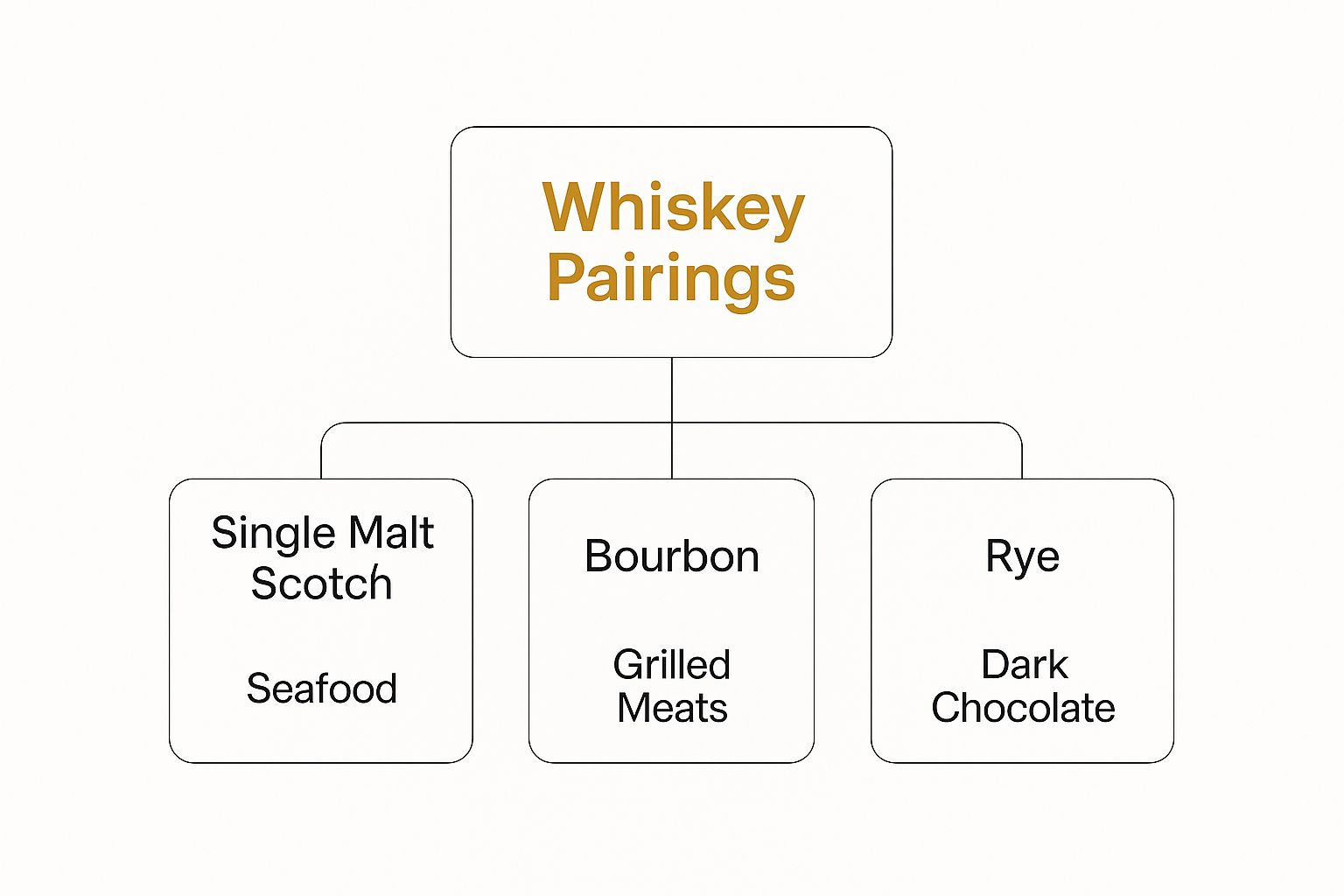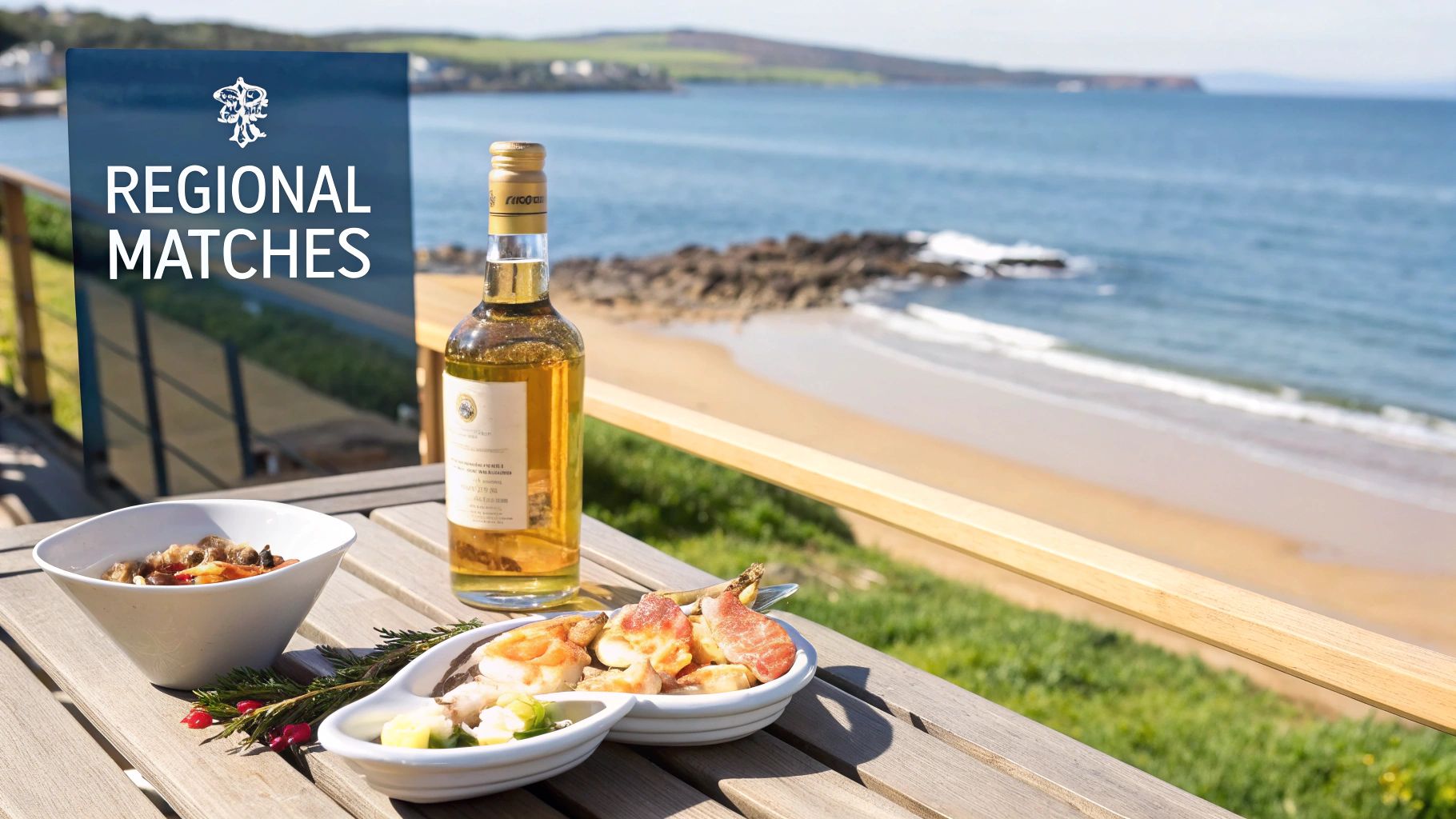Pairing food with whiskey is really all about one thing: matching intensity. You wouldn't pair a delicate white fish with a monster Cabernet, right? The same idea applies here. A light, smooth whiskey sings when paired with delicate foods like chicken or cheese, while a big, bold, smoky spirit can go toe-to-toe with rich dishes like a perfectly grilled steak or slow-smoked barbecue.
The whole point is to create a kind of harmony where neither the drink nor the dish shouts over the other.
Your First Step Into Whiskey and Food Pairing

Most people think of whiskey as a solo act, something best enjoyed in a leather armchair with a good book. While there’s absolutely nothing wrong with that, you're missing out on a huge world of flavor if you never bring it to the dinner table. When done right, pairing whiskey with food can elevate both, creating a dining experience that’s complex, satisfying, and way more accessible than you might think.
The core concept is simple: balance. You want the whiskey and the food to complement each other instead of competing for your attention.
For anyone new to this, it can sound a little intimidating, but trust me, it’s easier than it seems. You don’t need a sommelier’s pedigree to get started. Honestly, a bit of curiosity and a willingness to experiment are the only tools you really need.
Finding the Right Balance
Think of it like a conversation. If one person is shouting (a bold, cask-strength whiskey) and the other is whispering (a light salad), it’s not much of a conversation. It’s one-sided. But if both are speaking at a similar volume, they can interact in some pretty interesting ways.
The art of pairing isn’t about following a strict set of rules. It's about creating a balanced sensory experience. A great pairing lets the unique character of both the whiskey and the food shine, often revealing new and unexpected flavor notes in each.
Let's walk through a real-world example. Take a classic bourbon from an American craft distillery like FEW Spirits, with its signature notes of caramel, vanilla, and oak. It’s a phenomenal partner for smoked barbecue. The inherent sweetness in the bourbon cuts right through the richness of the meat, while its own subtle smokiness from the charred barrel echoes the cooking method. It just works.
To really nail these pairings, it helps to know what you're tasting. For a deep dive into identifying these notes, you can learn how to drink whiskey like a pro in our dedicated guide.
To get your first pairing adventure underway, here are a few foundational ideas:
- Light-Bodied Whiskeys: Think smoother bourbons or many classic Irish whiskeys. These get along great with leaner meats like roasted chicken, mild cheeses like a good cheddar, and even spiced desserts like apple pie.
- Medium-Bodied Whiskeys: This category includes a lot of rye whiskeys or well-balanced American single malts. They have enough backbone to handle richer foods like pork, aged Gouda, or a nice piece of dark chocolate.
- Full-Bodied Whiskeys: We're talking peated Scotch or high-proof, cask-strength bourbons. These demand robust, powerful flavors like grilled steak, funky blue cheese, or a rich, fatty brisket to match their intensity.
Quick-Start Whiskey Pairing Cheat Sheet
Feeling overwhelmed? Don't be. Think of this table as your easy-button for getting started. We've matched some common whiskey styles with easy-to-find foods that just click. No overthinking required.
| Whiskey Style | Flavor Profile | Try Pairing With |
|---|---|---|
| Bourbon | Sweet, Caramel, Vanilla, Oak | Grilled Steak, BBQ Ribs, Pecan Pie, Dark Chocolate |
| Rye Whiskey | Spicy, Peppery, Fruity | Cured Meats (Salami), Aged Cheddar, Smoked Pork |
| Irish Whiskey | Smooth, Light, Fruity, Floral | Roasted Chicken, Mild Cheeses, Smoked Salmon, Apple Crumble |
| Scotch (Unpeated) | Malty, Honeyed, Orchard Fruits | Seared Scallops, Creamy Pasta, Shortbread Cookies |
| Scotch (Peated) | Smoky, Briny, Medicinal | Blue Cheese, Oysters, Rich Brisket, Dark Chocolate Mousse |
This cheat sheet is your launchpad. The real fun begins when you start experimenting on your own and discover the pairings that you love. Happy tasting
Learning the Language of Whiskey Flavors

To really nail a memorable food and whiskey pairing, you first have to understand what’s going on in the glass. It’s a bit like learning a few key phrases in a new language—once you get the basics down, you can start having real conversations. With whiskey, that language is all about flavor profiles.
Most whiskeys can be sorted into four primary flavor "camps," which act as a roadmap for your palate. Spotting these notes is the first step toward making pairings that are intentional and, most importantly, delicious. And don't worry, you don’t need a super-palate to get started.
The Four Main Flavor Camps
Let's break down the foundational flavors you'll run into. Each one has a distinct personality that can either complement or contrast with food in some fantastic ways.
-
Sweet: This is often the most approachable profile, especially in American craft whiskey. We’re talking about those warm, comforting notes of caramel, vanilla, honey, and brown sugar. Classic bourbons, like many from Kentucky's craft distillers, are famous for these rich, dessert-like qualities they pull from their new charred oak barrels.
-
Spicy: This doesn't mean "hot" like a chili pepper. Instead, think of the sharp, tingling notes of cinnamon, black pepper, clove, and nutmeg. High-rye bourbons and, of course, rye whiskeys are the champions here. Brands like Catoctin Creek out of Virginia often deliver this bold, peppery kick.
-
Smoky: This is probably the most divisive yet beloved profile out there, created by drying malted barley over a peat fire. It brings powerful flavors of campfire smoke, earthy soil, and even a medicinal brine. Peated Scotch from Islay is the classic example, but a growing number of American distillers, such as Westland Distillery in Seattle, are crafting some truly incredible smoky single malts.
-
Fruity & Floral: This camp is all about subtlety and elegance. You might pick up notes of fresh apples, pears, citrus, or dried fruits like raisins and figs. Irish whiskeys and many Speyside Scotches are well known for these lighter, more delicate characteristics.
Tip for New Drinkers: If you find a whiskey too strong or "hot" at first, add a single drop of water to your glass. This can open up the spirit, taming the alcohol burn and making it easier to pick out those subtle sweet and fruity notes.
From Barrel to Flavor
The barrel is where the magic happens. A whiskey develops the majority of its flavor—often over 60%—during its time in the cask. The type of wood, the level of char, and the years spent aging all shape the final taste. If you want to go deeper on this, you can explore how wood is whiskey's best friend in our detailed article.
Developing your palate is a journey, not a test. The next time you pour a dram, just take a moment. Smell it, taste it, and see if you can place it in one of these four camps. Is it a sweet, caramel-forward bourbon? Or a spicy, assertive rye? That simple act builds your sensory vocabulary, and it's the absolute key to mastering the art of pairing.
Mastering the Art of Flavor Combinations
Now that you've got a handle on whiskey's flavor language, we can get to the fun part: playing matchmaker between your dram and your dinner. The goal here is simple. You want to introduce flavors that bring out the absolute best in each other, creating a combination that’s far more memorable than either the food or the whiskey would be on its own.
This matchmaking process really boils down to two main strategies: pairing through complement or through contrast. Both are fantastic tools for building an unforgettable tasting experience.
Complementary Pairings That Amplify Flavor
The first and most intuitive path is to find harmony in what's similar. A complementary pairing is all about matching like with like, layering flavors that are already in the same ballpark to really make a specific profile sing. Think of it like a guitarist playing a harmony over a lead vocal—it just enriches the original note and makes the whole thing sound bigger.
Let's say you pour a classic bourbon, one known for its deep caramel and vanilla sweetness. The perfect complementary partner would be something like a rich, creamy crème brûlée. The whiskey's sweet notes will echo the dessert’s caramelized sugar, making the whole experience feel more decadent and perfectly cohesive.
Here are a few more examples of this idea in action:
- A smoky American Single Malt with grilled steak: The char from the grill is a direct mirror of the smoky notes in the whiskey. Together, they create a powerful, unified flavor.
- A fruity, lighter-bodied bourbon with apple pie: The whiskey’s hints of orchard fruit will latch onto the baked apples, while its vanilla notes find a friend in the warm spices.
- An oak-forward whiskey with aged cheddar: Those nutty, savory notes in the cheese are a perfect match for the deep, woody character of a well-aged spirit.
Contrasting Pairings That Create Balance
The second approach is all about creating a little excitement through opposition. Contrasting pairings introduce different flavors that cut through, cleanse, or balance each other out. Instead of perfect harmony, you're looking for a dynamic tension that resolves beautifully on your palate.
It's the same reason a squeeze of lime brightens up a rich taco. That’s a contrast pairing.
A fantastic example in the whiskey world is matching a bold, spicy rye from an American craft brand like WhistlePig with a fatty, rich food like charcuterie or cured salami. That peppery bite of the rye cuts straight through the fat, cleansing your palate and getting you ready for the next bite. The whiskey doesn't steamroll the food; it resets it.
Pro Tip for New Drinkers: If you're just starting your pairing journey, begin with complementary pairings. They are generally more straightforward and forgiving. As your confidence grows, you can start diving into contrasting flavors to discover some truly exciting combinations.
This infographic lays out some classic pairings, from smoky Scotch with seafood to spicy rye with dark chocolate.

As you can see, the distinct profiles of Bourbon, Rye, and Scotch naturally lead them to very different food partners. Whether you choose to complement or contrast, the real goal is to create a balanced interaction where neither the spirit nor the dish gets lost in the shuffle.
Pairing American Craft Whiskey With Classic Dishes

Alright, enough theory. Let's get down to business and bring this to the dinner table. The American craft whiskey scene is practically exploding with creativity right now, which makes it the perfect playground for putting your new pairing skills to the test.
We're going to break down how three iconic American whiskey styles—Bourbon, Rye, and the exciting new kid on the block, American Single Malt—stack up against some classic, can't-miss dishes.
This isn't just about putting a random glass of whiskey next to a plate of food. It’s about building a bridge between the two, creating a combination where the spirit and the dish actually make each other better. We'll show you why these pairings sing, so you can start riffing and experimenting on your own.
Bourbon: The Quintessential American Spirit
Bourbon is defined by its corn-heavy mash bill and time spent in new charred oak barrels. This process gives it that signature sweet, welcoming profile full of caramel, vanilla, and warm oak. Honestly, it's about as food-friendly as a whiskey can get.
A perfect example of a complementary pairing? A good bourbon alongside slow-smoked BBQ pulled pork. The natural sweetness in the whiskey locks in with the brown sugar in a great barbecue sauce. At the same time, its oaky, slightly smoky backbone vibes with the whole cooking process. It’s a home run every single time.
Tip for New Drinkers: If you’re just starting your pairing journey, bourbon is your best friend. Its sweeter, more approachable profile makes it a fantastic entry point. You really can’t go wrong with a quality craft bourbon and a hearty meal.
If you’re thinking dessert, grab a wheated bourbon—they tend to be a bit softer and sweeter—and pour it next to a slice of pecan pie. The nutty, brown sugar goodness of the pie is practically a mirror image of the whiskey's sweet and toasty character.
Rye: The Spicy Counterpart
If bourbon is the friendly neighbor, rye is its spicy, opinionated cousin. Made with at least 51% rye grain, this whiskey comes with a signature peppery kick and a ton of baking spice notes. This makes it the ultimate tool for cutting through rich, fatty foods.
Think about a cheese and charcuterie board. A high-rye whiskey will slice right through the sharpness of an aged cheddar or the salty fattiness of a good salami. The spirit acts as a palate cleanser, resetting you for the next bite. It’s a beautiful dance of contrast.
This kind of thoughtful pairing is driving major interest. The U.S. whiskey market alone hit USD 13.3 billion in 2024, and a huge part of that is driven by drinkers enjoying premium bourbon and rye with complementary foods like smoked meats or rich cheeses. You can discover more insights about the global whiskey market on gminsights.com.
American Single Malt: The Emerging Innovator
American Single Malts are, without a doubt, one of the most exciting things happening in craft spirits. Distillers here aren't tied down by the strict rules you see in Scotland, so they have the freedom to play and innovate. These whiskeys are made from 100% malted barley and can run the gamut from light and fruity to deep and smoky.
Want a deeper dive? We've got a whole guide on exploring the impact of barrel types on American craft whiskey.
For a more delicate pairing, find a lighter, fruit-forward American Single Malt and try it with grilled salmon. The whiskey's gentle malt sweetness and notes of apple or pear will complement the fish without steamrolling it. For something with more heft, a moderately peated single malt (like one from Westland Distillery in Seattle) would be incredible with roasted root vegetables. The earthy smoke will pull out their natural sweetness beautifully.
Exploring International Whiskey and Food Pairings
Sure, American craft whiskey is a fantastic playground for food pairings, but the moment you look beyond our borders, a whole world of delicious, cross-cultural combinations opens up. It’s one of the best ways to truly appreciate the sheer versatility of whiskey—turning your dinner into an impromptu global tour.
The old rules of thumb still apply, of course. You're still matching intensity and looking for flavors that either complement or contrast. But when you introduce the briny coasts of Scotland or the umami-rich broths of Japan, you’ve got an entirely new sandbox to play in. A little adventurous spirit here can lead to some seriously memorable discoveries.
For anyone new to whiskey, this is a perfect way to connect the dots between how different production styles create such unique flavors. Take a smoky, peaty Islay Scotch, for instance. It just has a natural, almost primal, affinity for the sea.
Classic Global Pairings
Let's start with some of the tried-and-true combinations, the pairings that have been celebrated for a reason—they just work.
- Smoky Islay Scotch with Oysters: That briny, almost medicinal smoke you get from an Islay single malt is a knockout partner for the salty, fresh minerality of raw oysters. The whiskey slices right through and cleanses the palate, making for a powerful, unforgettable sensory hit.
- Fruity Speyside Scotch with a Cheese Board: A lighter, fruit-forward Speyside, with its characteristic notes of apple and honey, is a dream with creamy cheeses like Brie or nutty ones like an aged Gouda. It’s a pairing that highlights both without one overpowering the other.
- Smooth Irish Whiskey with Smoked Salmon: The mellow, often triple-distilled smoothness of a good Irish whiskey is the perfect counterpart for the delicate, oily texture of smoked salmon. Its subtle fruit and floral notes seem to lift the entire dish.
Venturing into Cross-Cultural Pairings
Okay, this is where the real fun starts. Bringing American whiskeys to the global table creates some dynamic and completely unexpected flavor conversations. The sweet, bold character of many American whiskeys offers a fantastic counterpoint to the spicy, savory, and umami-rich profiles lighting up so much of Asian cuisine.
Beginner's Tip: Don't be afraid to be adventurous. The "rules" are just guidelines. Pairing a sweet American bourbon with spicy Korean BBQ or a bold rye with Japanese ramen can create some of the most memorable and exciting flavor experiences.
This kind of experimentation is really taking off as American whiskey gains fans in global markets. Valued at about USD 9.06 billion in 2021, the American whiskey scene is seeing huge growth in Asia Pacific markets, which is naturally sparking some incredibly creative pairings. You can get a deeper look into this trend and read the full market analysis from Market.us.
Think about giving these matchups a try:
- Bourbon with Korean BBQ: The sweet caramel and vanilla backbone of a classic bourbon is a fantastic foil for the spicy, savory gochujang and soy flavors in dishes like bulgogi or galbi. The whiskey’s sweetness helps tame the heat, while its oaky char perfectly complements the grilled meat.
- Rye with Japanese Ramen: A spicy, high-rye whiskey has the backbone to stand up to the rich, umami-heavy broth of a good tonkotsu ramen. That peppery kick cuts right through the fattiness of the chashu pork, creating a delicious, satisfying balance.
These pairings prove that the "rules" are really just jumping-off points. Once you start treating whiskey as the truly global spirit it is, your options for pairing it with food become virtually limitless.
Common Whiskey Pairing Questions Answered
Even with a good roadmap, heading into the world of whiskey and food pairing can kick up a few questions. Let's tackle some of the most common ones we hear. This should give you the confidence to start pairing, whether you're just dipping your toes in or looking to fine-tune your choices.
Think of this as your go-to reference. The goal is to clear up any lingering doubts and get you excited about experimenting with some fun, new combinations.
What Is the Best Whiskey for Beginners to Start Pairing?
For anyone just getting into this, the answer is almost always a classic American bourbon. It's the perfect training ground. Something like a bourbon from FEW Spirits out of Illinois often brings those really approachable caramel, vanilla, and sweet corn notes to the front, making it incredibly easy to pair with food.
Bourbon's natural sweetness and smoother profile just work with a massive range of everyday dishes. We're talking everything from grilled chicken and burgers all the way to a slice of apple pie. It’s a forgiving and delicious starting point for your pairing journey.
Can I Pair Whiskey with Spicy Food?
You absolutely can. Pairing whiskey with spicy food is all about finding the right balance.
A full-bodied, sweet bourbon can be a fantastic partner for something with a bit of a kick, like Nashville hot chicken or a spicy BBQ. The whiskey's sweetness acts as the perfect counterweight, cooling down the heat just enough without killing the flavor.
Another route is to go with a bold, high-rye whiskey that has enough backbone to stand up to the spice and complement it. The only real rule is to avoid pouring a delicate or floral whiskey next to intensely spicy food—the heat will just completely overpower the spirit's finer points.
When you're pairing with spice, think of the whiskey's sweetness as your secret weapon. It can tame the heat on your palate, which lets the complex flavors of both the dish and the drink come through for a much more balanced experience.
How Do Flavored Whiskeys Change Pairing Rules?
Flavored whiskeys, which have absolutely exploded in popularity, make pairing much more direct and intuitive. It's no surprise the flavored whiskey market is on track to hit USD 49.34 billion by 2030; it’s a super accessible way for new drinkers to get into the culture. You can learn more about how younger drinkers are jumping on this trend by exploring the flavored whiskey market report on mordorintelligence.com.
When you're pairing with them, just treat that dominant flavor as your guide.
- An apple-flavored whiskey is a no-brainer with pork chops or a sharp cheddar cheese, just like you’d use an apple chutney.
- A honey whiskey sings alongside fried chicken or a bowl of glazed nuts.
- Got a peach whiskey? It’s a natural with desserts like cobbler or a simple scoop of vanilla ice cream.
These spirits offer a fun, straightforward way to create some really delicious combinations, taking a lot of the usual guesswork out of the picture.
Ready to discover your next favorite American craft whiskey? At Blind Barrels, we remove brand bias and let your palate lead the way. Our blind tasting kits feature exceptional spirits from small, independent distilleries across the country, delivered right to your door. Join our club and start your tasting adventure today at https://www.blindbarrels.com.
Article created using Outrank
